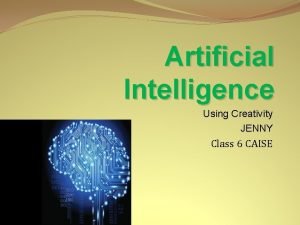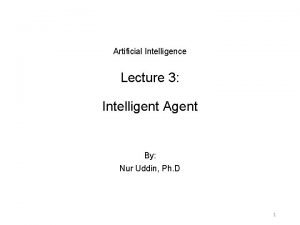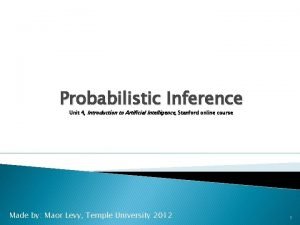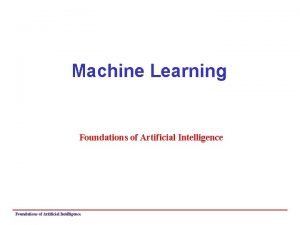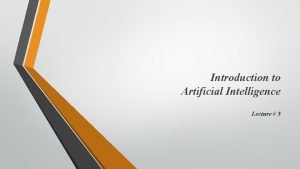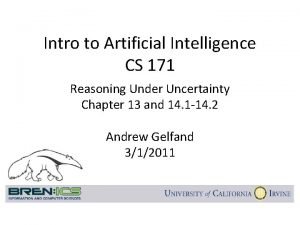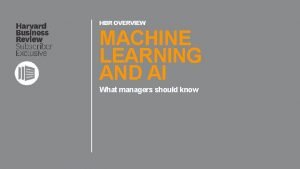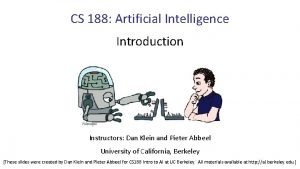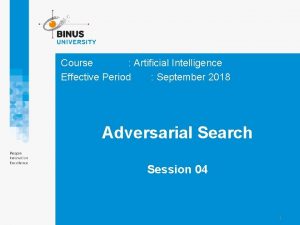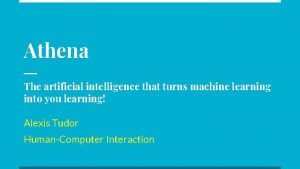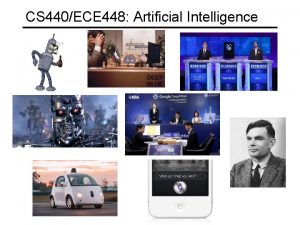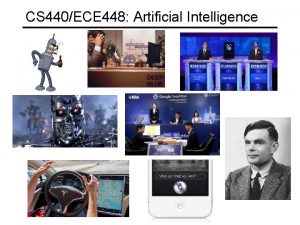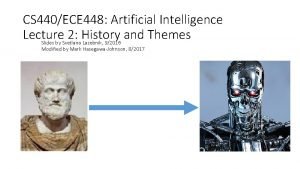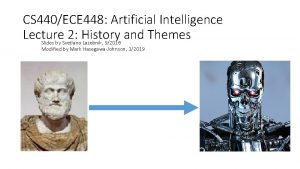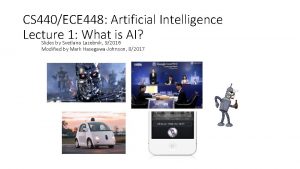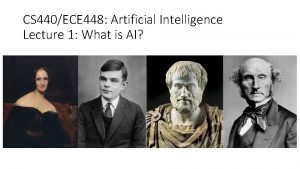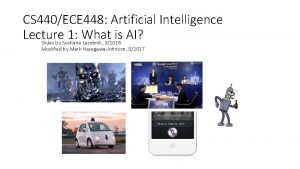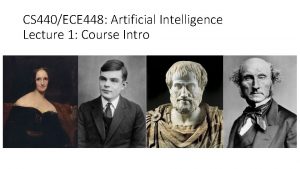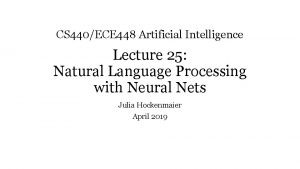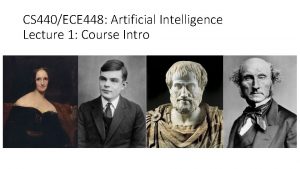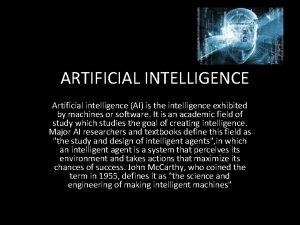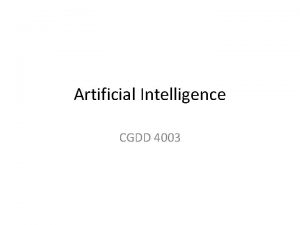CS 440ECE 448 Artificial Intelligence Lecture 2 History


































- Slides: 34

CS 440/ECE 448: Artificial Intelligence Lecture 2: History and Themes Slides by Svetlana Lazebnik, 9/2016 Modified by Mark Hasegawa-Johnson, 1/2019

Last time: What is AI? • Thinking Humanly? • Examples: embodied cognition, trying to reconstruct a brain cell-by-cell • Acting Humanly? • Examples: Turing test, Winograd schema • Thinking Rationally? • Example: Aristotle, especially the Analytics • Example: the logicist approach to AI, symbolic reasoning, fuzzy logic • Acting Rationally? • Example: John Stuart Mill, Utilitarianism • Example: rational agent theory, Economics

AI: History and themes https: //www. youtube. com/watch? v=BFWt 5 Bxfcjo Image source

What are some successes of AI today? • … • … • …

IBM Watson and “cognitive computing” • 2010 NY Times article, trivia demo • February 2011: IBM Watson wins on Jeopardy • Since then: Watson Analytics, social services, personal shopping, health care

Self-driving cars Google News snapshot as of August 22, 2016

Speech and natural language • Instant translation with Word Lens • Have a conversation with Google Translate https: //www. skype. com/en/features/skype-translator/ http: //googleblogspot. com/2015/01/hallo -hola-more-powerful-translate. html

Computer Vision

Games • 1997: IBM’s Deep Blue defeats the reigning world chess champion Garry Kasparov • 1996: Kasparov Beats Deep Blue “I could feel – I could smell – a new kind of intelligence across the table. ” • 1997: Deep Blue Beats Kasparov “Deep Blue hasn't proven anything. ” • 2007: Checkers is solved • Though checkers programs had been beating the best human players for at least a decade before then • 2014: Heads-up limit Texas Hold-em poker is solved • First game of imperfect information • 2016: Alpha. Go computer beats Go grandmaster Lee Sedol 4 -1

Mathematics • In 1996, a computer program written by researchers at Argonne National Laboratory proved a mathematical conjecture unsolved for decades • NY Times story: “[The proof] would have been called creative if a human had thought of it” • Mathematical software:

Logistics, scheduling, planning • During the 1991 Gulf War, US forces deployed an AI logistics planning and scheduling program that involved up to 50, 000 vehicles, cargo, and people • NASA’s Remote Agent software operated the Deep Space 1 spacecraft during two experiments in May 1999 • In 2004, NASA introduced the MAPGEN system to plan the daily operations for the Mars Exploration Rovers

Robotics • Mars rovers • Autonomous vehicles • DARPA Grand Challenge • Self-driving cars • Autonomous helicopters • Robot soccer • Robo. Cup • Personal robotics • Humanoid robots • Robotic pets • Personal assistants?

Origins of AI: Early excitement • 1940 s First model of a neuron (W. S. Mc. Culloch & W. Pitts) • Hebbian learning rule • Cybernetics • 1950 s Turing Test • Perceptrons (F. Rosenblatt) • Computer chess and checkers (C. Shannon, A. Samuel) • Machine translation (Georgetown-IBM experiment) • Theorem provers (A. Newell and H. Simon, H. Gelernter and N. Rochester) • 1956 Dartmouth meeting: “Artificial Intelligence” adopted

1939: Hodgkin & Huxley Measure the…

1943: Mc. Culloch-Pitts Neuron Model Attribution: Plarroy, https: //commons. wikimedia. org/wiki/File: Artificial_neuron. png

An Electronic Model of Neural Learning: the Perceptron, 1957, Rosenblatt Attribution: Cornell University Library


Herbert Simon, 1957 • “It is not my aim to surprise or shock you – but … there are now in the world machines that think, that learn and that create. Moreover, their ability to do these things is going to increase rapidly until – in a visible future – the range of problems they can handle will be coextensive with the range to which human mind has been applied. More precisely: within 10 years a computer would be chess champion, and an important new mathematical theorem would be proved by a computer. ” • Prediction came true – but 40 years later instead of 10

Harder than originally thought • 1966: Eliza chatbot (Weizenbaum) • “ … mother …” → “Tell me more about your family” • “I wanted to adopt a puppy, but it’s too young to be separated from its mother. ” • 1954: Georgetown-IBM experiment • Completely automatic translation of more than sixty Russian sentences into English • Only six grammar rules, 250 vocabulary words, restricted to organic chemistry • Promised that machine translation would be solved in three to five years (press release) • Automatic Language Processing Advisory Committee (ALPAC) report (1966): machine translation has failed • “The spirit is willing but the flesh is weak. ” → “The vodka is strong but the meat is rotten. ”

The ALPAC Report of 1966 “They concluded, in a famous 1966 report, that machine translation was more expensive, less accurate and slower than human translation. ” Photo: Eldon Lyttle, https: //commons. wikimedia. org/wiki/File: Computertranslation_Briefing_for_Ger ald_Ford. jpg

The Lighthill Report, 1973: combinatorial explosion is the key problem

Blocks world (1960 s – 1970 s) Larry Roberts, MIT, 1963 ? ? ?


History of AI to the present day • 1975 -1985: Expert systems boom • 1985 -1995: Expert system bust; the second “AI winter” • Expert system, brief comic explanation: • https: //www. youtube. com/watch? v=sg 6 h. Lmuy. Q 54 • 1995 -2009: The probabilistic reasoning/ Bayesian logic boom • 2009 -present: Deep learning • Neural nets solve the expert system problems: • https: //www. youtube. com/watch? v=n-Yb. Ji 4 EPxc History of AI on Wikipedia Building Smarter Machines: NY Times Timeline

What accounts for recent successes in AI? • Faster computers • The IBM 704 vacuum tube machine that played chess in 1958 could do about 50, 000 calculations per second • Deep Blue could do 50 billion calculations per second – a million times faster! • Dominance of statistical approaches, machine learning • Big data • Crowdsourcing



Historical themes • Boom and bust cycles • Periods of (unjustified) optimism followed by periods of disillusionment and reduced funding • Silver bulletism (Levesque, 2013): • “The tendency to believe in a silver bullet for AI, coupled with the belief that previous beliefs about silver bullets were hopelessly naïve” • Image problems • “AI effect”/Moravec’s paradox: As soon as a machine gets good at performing some task, the task is no longer considered to require much intelligence • AI as a threat to safety? • AI as a threat to jobs?

AI Effect/Moravec’s paradox • “It is comparatively easy to make computers exhibit adult level performance on intelligence tests or playing checkers, and difficult or impossible to give them the skills of a one-year-old when it comes to perception and mobility” [Hans Moravec, 1988] • Why is this? • Early AI researchers concentrated on the tasks that they themselves found the most challenging, abilities of animals and two-year-olds were overlooked • We are least conscious of what our brain does best • Sensorimotor skills took millions of years to evolve, whereas abstract thinking is a relatively recent development

http: //www. v 3. co. uk/v 3 uk/news/2419567/aiweapons-are-a-threat-tohumanity-warn-hawkingmusk-and-wozniak

http: //www. bbc. com/news/technology-30290540 http: //www. wired. com/2015/01/elon-musk-ai-safety/

http: //www. theguardian. com/technology/2014/aug /06/robots-jobs-artificial-intelligence-pew

In this class • Part 1: sequential reasoning (MP 1, MP 2) • Part 2: pattern recognition and learning (MP 3, MP 4)

Philosophy of this class • Goal: use machines to solve hard problems that are traditionally thought to require human intelligence • We will try to follow a sound scientific/engineering methodology • Consider relatively limited application domains • Use well-defined input/output specifications • Define operational criteria amenable to objective validation • Zero in on essential problem features • Focus on principles and basic building blocks
 Expert system shells
Expert system shells State space representation in ai
State space representation in ai Searching for solutions in artificial intelligence
Searching for solutions in artificial intelligence 15-780 graduate artificial intelligence
15-780 graduate artificial intelligence Knowledge manipulation in ai
Knowledge manipulation in ai Structural knowledge in ai
Structural knowledge in ai Colbert, stephen. home page. 1 nov. 2006.
Colbert, stephen. home page. 1 nov. 2006. Artificial intelligence leadership
Artificial intelligence leadership Uas kecerdasan buatan
Uas kecerdasan buatan Math and artificial intelligence
Math and artificial intelligence Peas description examples in ai
Peas description examples in ai 15-780 graduate artificial intelligence
15-780 graduate artificial intelligence Xkcd machine learning
Xkcd machine learning Fuzzy propositions examples
Fuzzy propositions examples Cse 571 artificial intelligence
Cse 571 artificial intelligence 15 780
15 780 Informed and uninformed search in artificial intelligence
Informed and uninformed search in artificial intelligence What is artificial intelligence class 6
What is artificial intelligence class 6 Augmented grammar in artificial intelligence
Augmented grammar in artificial intelligence Omniscience in artificial intelligence
Omniscience in artificial intelligence Importance of turing test in artificial intelligence
Importance of turing test in artificial intelligence Artificial intelligence class 8 chapter 3 solutions
Artificial intelligence class 8 chapter 3 solutions Semantic network in ai
Semantic network in ai Hananel hazan
Hananel hazan Artificial intelligence thesis proposals
Artificial intelligence thesis proposals Rule based deduction system
Rule based deduction system Inference by enumeration in artificial intelligence
Inference by enumeration in artificial intelligence Learning in ai
Learning in ai Ucs
Ucs Pxdes
Pxdes Optimal decisions in games in artificial intelligence
Optimal decisions in games in artificial intelligence Andrew ng hbr
Andrew ng hbr Cs 188
Cs 188 Optimal decisions in games in artificial intelligence
Optimal decisions in games in artificial intelligence Athena machine learning
Athena machine learning

















